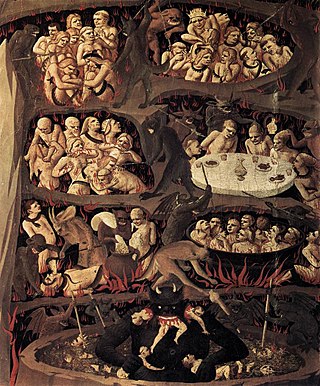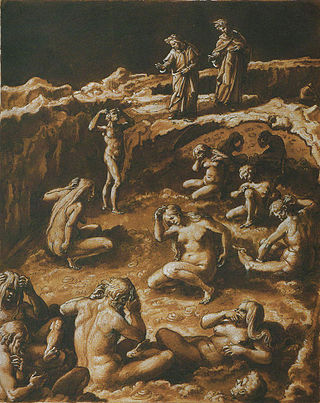Related Research Articles

Damnation is the concept of divine punishment and torment in an afterlife for actions that were committed, or in some cases, not committed on Earth.
The problem of Hell is an ethical problem in the Abrahamic religions of Christianity, Islam and Judaism, in which the existence of Hell (Jahannam) for the punishment of souls in the Afterlife is regarded as inconsistent with the notion of a just, moral, and omnipotent, omnibenevolent, omniscient supreme being. Also regarded as inconsistent with such a just being is the combination of human free will, and the divine qualities of omniscience and omnipotence, as this would mean God would determine everything that has happened and will happen in the universe—including sinful human behavior.

In Dante Alighieri's Inferno, part of the Divine Comedy, Malebolge or Fraud is the eighth circle of Hell. Roughly translated from Italian, Malebolge means "evil ditches". Malebolge is a large, funnel-shaped cavern, itself divided into ten concentric circular trenches or ditches. Each trench is called a bolgia. Long causeway bridges run from the outer circumference of Malebolge to its center, pictured as spokes on a wheel. At the center of Malebolge is the ninth and final circle of hell, known as Cocytus.

In Christian theology, universal reconciliation is the doctrine that all sinful and alienated human souls—because of divine love and mercy—will ultimately be reconciled to God. The doctrine has been rejected by most mainstream Christian churches, which tend to maintain at least the possibility that many are not saved, but it has received support from many prestigious Christian thinkers as well as many groups of Christians. It has been argued that the Bible itself has a variety of verses that seem to support a plurality of views.

Daniel Whitby (1638–1726) was a controversial English theologian and biblical commentator. An Arminian priest in the Church of England, Whitby was known as strongly anti-Calvinistic and later gave evidence of Unitarian tendencies.

Trinitarian universalism is a variant of belief in universal salvation, the belief that every person will be saved, that also held the Christian belief in Trinitarianism. It was particularly associated with an ex-Methodist New England minister, John Murray, and after his death in 1815 the only clergy known to be preaching Trinitarian Universalism were Paul Dean of Boston and Edward Mitchell in New York.

In religion and folklore, hell is a location or state in the afterlife in which souls are subjected to punitive suffering, most often through torture, as punishment after death. Religions with a linear divine history often depict hells as eternal destinations, the biggest examples of which are Christianity and Islam, whereas religions with reincarnation usually depict a hell as an intermediary period between incarnations, as is the case in the Dharmic religions. Religions typically locate hell in another dimension or under Earth's surface. Other afterlife destinations include heaven, paradise, purgatory, limbo, and the underworld.

Matthew 8:12 is the twelfth verse of the eighth chapter of the Gospel of Matthew in the New Testament. This verse is part of the conclusion to the miracle story of healing the centurion's servant, the second of a series of miracles in Matthew. This verse warns that many Jews are lacking in faith after praising the Gentile Centurion in the previous verse for his.
Matthew 10:28 is a verse in the ninth chapter of the Gospel of Matthew in the New Testament.

In Christian theology, Hell is the place or state into which, by God's definitive judgment, unrepentant sinners pass in the general judgment, or, as some Christians believe, immediately after death. Its character is inferred from teaching in the biblical texts, some of which, interpreted literally, have given rise to the popular idea of Hell. Theologians today generally see Hell as the logical consequence of rejecting union with God and with God's justice and mercy.

Elizabeth Cellier, commonly known as the "Popish Midwife", was a notable Catholic midwife in seventeenth-century England. She stood trial for treason in 1679 for her alleged part in the "Meal-Tub Plot" against the future King James II, but was eventually freed. Cellier was later imprisoned for allegations made in her 1680 work Malice Defeated, in which she recounted the events of the alleged conspiracy against the future King. She later became a pamphleteer and advocated for advancements in the field of midwifery. Cellier published A Scheme for the Foundation of a Royal Hospital in 1687, where she outlined plans for a hospital and a college for instructions in midwifery, as well as proposing that midwives of London should enter into a corporation and use their fees to establish parish houses where any woman could give birth. Cellier resided in London, England until her death.

Torment is a 1950 British second feature thriller film directed by John Guillermin and starring Dermot Walsh, Rona Anderson and John Bentley.

Naraka is the realm of existence in Jain cosmology characterized by great suffering. Naraka is usually translated into English as "hell" or "purgatory".
In Christianity, annihilationism is the belief that after the Last Judgment, all damned humans and fallen angels including Satan will be totally destroyed, cremated, and their consciousness extinguished rather than suffering forever in Hell. Annihilationism stands in contrast to both the belief in eternal torment and the belief that everyone will be saved ("universalism"). However, it is also possible to hold to a partial annihilationism, believing unsaved humans to be obliterated or cremated, but demonic beings to suffer forever.
John Brandon may refer to:
Dryhthelm, also known as Drithelm or Drythelm, was a monk associated with the monastery of Melrose known from the Historia Ecclesiastica gentis Anglorum of Bede. According to the latter, before entering the religious life he lived with his family in "a district of Northumbria which is called Incuneningum". Incuneningum is thought by some modern scholars to refer to Cunninghame, now part of Ayrshire.
William Sherwin was an English engraver, one of the first to work with mezzotints.

Naraka, also called Yamaloka, is the Hindu equivalent of Hell, where sinners are tormented after death. It is also the abode of Yama, the god of Death. It is described as located in the south of the universe and beneath the earth.
Samuel Richardson was an English layman and religious controversialist of the 1640s and 1650s, of Baptist views.

The Pamphlet of Rigas Feraios is a large chalcography printed in Vienna in 1797 by Rigas Feraios. It depicts a portrait of Alexander the Great framed by war scenes and portraits of his generals. The etching was incised by François Müller, who cooperated with Rigas for his cartographic work which he published the same year: Rigas' Map of Greece (1797), the New Map of Wallachia and part of Transylvania (1797) and the General Map of Moldavia (1797). It was released in 1200 copies from the printing press of Nitsch. One of the two copies that have been discovered in Greece is displayed in the National Historical Museum of Greece.
References
- Stephen, Leslie, ed. (1886). . Dictionary of National Biography . Vol. 6. London: Smith, Elder & Co.